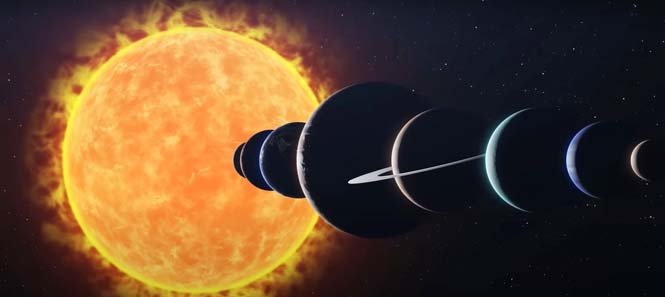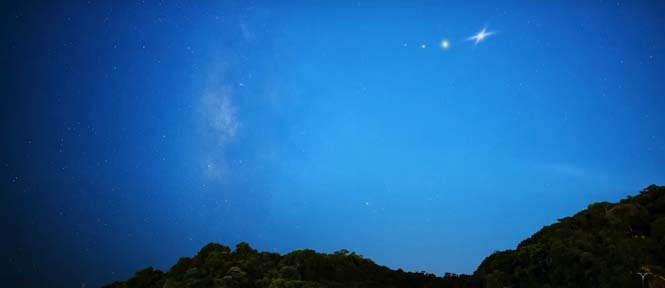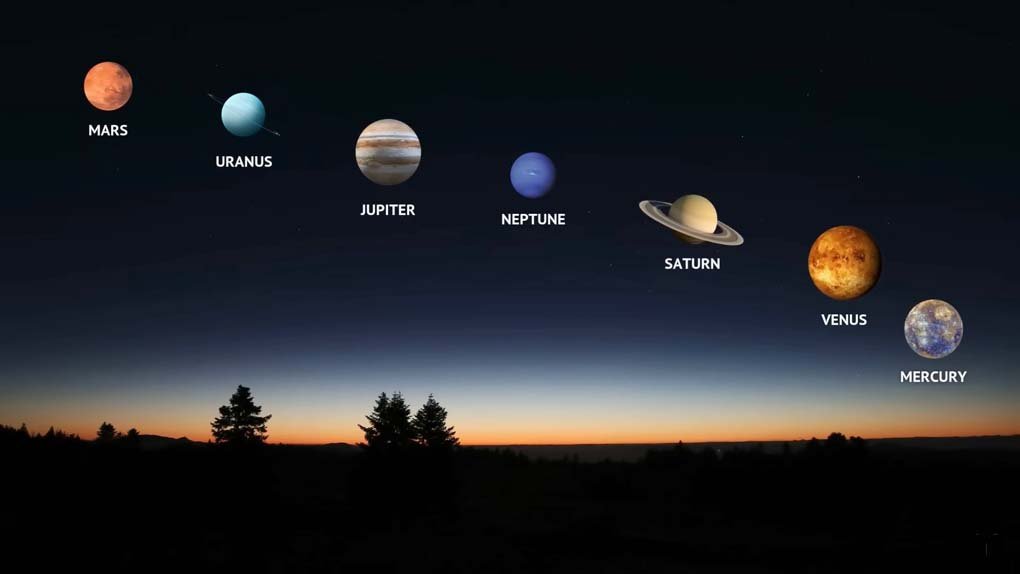Introduction:
In an event that has astronomers and stargazers buzzing, seven planets in our solar system will align in a rare cosmic spectacle visible from Earth in 2025. Mercury, Venus, Mars, Jupiter, Saturn, Uranus, and Neptune will form a near-straight line across the night sky, offering a dazzling display not seen in over two decades. This planetary parade, peaking in visibility during late June and early July 2025, promises to be a breathtaking sight—one that could inspire a new generation of space enthusiasts. Let’s unpack the science, history, and human stories behind this celestial phenomenon.
The Science Behind the Alignment
Planetary arrangements, or “syzygies,” happen when numerous planets assemble closely on one side of the Sun from Earth’s point of view. Whereas conjunctions between two or three planets happen each few a long time, a seven-planet arrangement is outstandingly uncommon. According to NASA’s Jet Propulsion Laboratory, the last time seven planets adjusted was in 2000, and the another won’t happen until 2040.
What makes the 2025 occasion special is its perceivability. Not at all like the 2000 arrangement, which was obscured by sunlight, the 2025 spectacle will be best viewed just before dawn in the Northern Hemisphere. “This is a brilliant opportunity for beginner astronomers,” says Dr. Emily Carter, an astrophysicist at the European Space Agency. “You won’t require a telescope to spot Jupiter, Venus, or Saturn, but binoculars will offer assistance capture Uranus and Neptune.”
Best Times and Places to Watch
Timing is everything. The arrangement will be most sensational between June 24 and July 5, 2025, with peak visibility around June 28. Skywatchers in rustic regions with negligible light pollution—think deserts, mountains, or open plains—will get the clearest view. Be that as it may, indeed city dwellers can see brighter planets like Venus and Jupiter.
Sky & Telescope magazine recommends heading outside about 90 minutes before sunrise and facing east. Mercury will appear low on the horizon, while Saturn and Neptune will glow higher in the sky. For those in the Southern Hemisphere, the planets will arc across the northern sky.
Historical and Cultural Significance
Planetary alignments have long captivated humanity. Old civilizations, from the Maya to the Babylonians, seen them as signs. The 2025 occasion coincides with the 50th commemoration of NASA’s Voyager missions, which to begin with given close-up pictures of the external planets. “It’s poetic,” says Dr. Raj Patel, a student of history of science at Cambridge University. “This alignment reminds us how far we’ve come in understanding our cosmic neighborhood.”
In modern times, such events spark communal gatherings. Amateur astronomy clubs worldwide are already planning “star parties,” while apps like Star Walk and Stellarium are updating their databases to help users track the planets.

The Human Angle: Stories of Anticipation
For many, the alignment is personal. Take Maria Gonzalez, a high school teacher in Arizona, who plans to camp under the stars with her students. “Events like this make science tangible,” she says. “Some kids have never seen Saturn’s rings. This could change their lives.”
Meanwhile, in Japan, 72-year-old Yoshiko Tanaka recalls watching the 1982 alignment with her late husband. “We were newlyweds, lying on a hilltop for hours,” she says. “This time, I’ll bring my grandchildren. The sky connects generations.”
Not everyone is celebrating, though. Light pollution activists warn that 80% of the global population lives under skyglow, which could obscure the view. Organizations like the International Dark-Sky Association are campaigning for temporary outdoor lighting reductions in cities during the alignment period.
Scientific Implications
Beyond its visual splendor, the alignment offers research opportunities. Scientists will study gravitational interactions between the planets, which could refine models of solar system dynamics. The European Space Agency’s JUICE mission, en route to Jupiter’s moons, may even capture data during the event.
Additionally, the alignment provides a chance to observe planetary atmospheres. “When planets cluster, their reflected light can be analyzed collectively,” explains Dr. Carter. “This helps us compare atmospheric compositions, like why Venus’s clouds differ from Saturn’s.”
How to Prepare: Tips for Stargazers
- Mark Your Calendar: Set reminders for late June 2025.
- Scout Areas: Utilize light pollution maps (e.g., DarkSiteFinder) to discover dark skies nearby.
- Gear Up: Whereas naked-eye seeing works for brighter planets, binoculars or a basic telescope will enhance the experience.
- Check Weather: Cloud cover can ruin the show. Have backup dates ready.
- Join a Community: Local astronomy clubs often host viewing events. Check out our guide to [finding stargazing groups near you].

Looking Ahead: The Legacy of Cosmic Events
The 2025 arrangement isn’t just a brief wonder—it’s a catalyst for interest. Past celestial events, like the 2017 solar eclipse, impelled surges in STEM enrollment. Educators hope this alignment will reignite public interest in space exploration, particularly with NASA’s Artemis missions pointing to return people to the Moon by 2026.
As Dr. Patel notes, “The night sky is humanity’s oldest classroom. When seven planets align, we’re reminded that we’re part of something vast and extraordinary.”
Conclusion:
The 2025 planetary alignment is more than a rare astronomical event; it’s a global invitation to look up and wonder. Whether you’re a seasoned astronomer or a casual observer, this cosmic gathering offers a chance to connect with the universe—and each other. As Yoshiko Tanaka puts it, “The stars remind us we’re all under the same sky.” Don’t miss your front-row seat to the greatest show in the solar system.
Related Video:
Sources:
- NASA Jet Propulsion Laboratory,
- European Space Agency,
- Sky & Telescope Magazine,
- International Dark-Sky Association,
- Interview with Dr. Raj Patel (Cambridge University),
- Personal testimonies from Maria Gonzalez and Yoshiko Tanaka.
Explore More:
- China Unveils Staggering Thorium Reserves, Igniting Nuclear Surge
- Innovative Solar Reactor Transforms CO2 Into Fuel & Sparks Change
- Earth’s Inner Core Is Shifting—A Discovery That Changes Science
- Hubble Reveals Stunning Nine-Ring Galaxy, A Cosmic Mystery
- Japan’s Solar Breakthrough: Can It Replace 20 Nuclear Reactors by 2040?
- China’s ‘Artificial Sun’ Breaks Fusion Record, Sparking Global Hope
- Unprepared for Volcanic Chaos: Scientists Warn of Imminent Global Threats
- Historic Sun Flyby: Parker Solar Probe’s Survival In Question
- NASA’s Parker Solar Probe Lost Contact: A Deep Dive Into The Causes And Challenges

